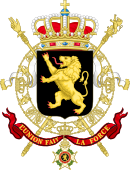1921 Belgian general election
| |||||||||||||||||||||||||||||||||||||||||
186 seats in the Chamber of Representatives 93 seats in the Senate | |||||||||||||||||||||||||||||||||||||||||
|---|---|---|---|---|---|---|---|---|---|---|---|---|---|---|---|---|---|---|---|---|---|---|---|---|---|---|---|---|---|---|---|---|---|---|---|---|---|---|---|---|---|
| |||||||||||||||||||||||||||||||||||||||||
| |||||||||||||||||||||||||||||||||||||||||
 |
|---|
|
General elections were held in Belgium on 20 November 1921.[1] The result was a victory for the Catholic Party, which won 70 of the 186 seats in the Chamber of Representatives.[2] Voter turnout was 91.1% in the Chamber election and 91.0% in the Senate election.[3]
Elections to the nine provincial councils were held one week later, on 27 November 1921.
A Catholic–Liberal government led by Georges Theunis was formed following the elections.
Results[]
Chamber of Representatives[]
 | |||||||||
| Party | Votes | % | Seats | +/– | |||||
|---|---|---|---|---|---|---|---|---|---|
| Belgian Labour Party | 672,478 | 34.81 | 68 | –2 | |||||
| Catholic Party | 657,245 | 34.02 | 70 | 0 | |||||
| Liberal Party | 343,959 | 17.80 | 33 | –1 | |||||
| Frontpartij | 58,790 | 3.04 | 4 | –1 | |||||
| Christene Volkspartij | 57,183 | 2.96 | 6 | New | |||||
| Catholic Dissidents | 42,856 | 2.22 | 3 | 0 | |||||
| Christian Workers' Alliance | 26,392 | 1.37 | 1 | New | |||||
| Combatants | 19,401 | 0.3 | 1 | -1 | |||||
| Other parties | 53,662 | 2.78 | 0 | 0 | |||||
| Invalid/blank votes | 95,349 | – | – | – | |||||
| Total | 2,027,315 | 100 | 186 | 0 | |||||
| Source: Belgian Elections | |||||||||
Senate[]
A constitutional change eased the requirements to be a candidate for the Senate. As a compensation, the number of senators elected by provincial councils was increased from 27 to 40 and a new type of senators was introduced: 20 co-opted senators. This gives a total of 153 senators.
 | |||||||||
| Party | Votes | % | Seats | +/– | |||||
|---|---|---|---|---|---|---|---|---|---|
| Belgian Labour Party | 661,168 | 35.48 | 33 | +13 | |||||
| Catholic Party | 606,799 | 32.57 | 34 | –9 | |||||
| Liberal Party | 362,187 | 19.44 | 18 | -12 | |||||
| United Catholics Party | 93,061 | 4.99 | 5 | New | |||||
| Christene Volkspartij | 51,928 | 2.79 | 2 | New | |||||
| Catholic Workers' Alliance | 16,588 | 0.89 | 1 | New | |||||
| Other parties | 71,601 | 3.84 | 0 | 0 | |||||
| Invalid/blank votes | 0 | – | – | – | |||||
| Total | 1,863,332 | 100 | 93 | 0 | |||||
| Source: Belgian Elections | |||||||||
Constituencies[]
The distribution of seats among the electoral districts was as follows:[4][5]
| Province | Arrondissement(s) | Chamber | Senate |
|---|---|---|---|
| Antwerp | Antwerp | 15 | 7 |
| Mechelen | 5 | 5 | |
| Turnhout | 4 | ||
| Elected by the provincial council | 5 | ||
| Limburg | Hasselt | 3 | 4 |
| Tongeren-Maaseik | 4 | ||
| Elected by the provincial council | 3 | ||
| East Flanders | Aalst | 5 | 4 |
| Oudenaarde | 3 | ||
| Gent-Eeklo | 12 | 6 | |
| Dendermonde | 4 | 4 | |
| Sint-Niklaas | 4 | ||
| Elected by the provincial council | 5 | ||
| West Flanders | Bruges | 4 | 2 |
| Roeselare-Tielt | 5 | 3 | |
| Kortrijk | 5 | 4 | |
| Ypres | 3 | ||
| Veurne-Diksmuide-Ostend | 5 | 2 | |
| Elected by the provincial council | 4 | ||
| Brabant | Leuven | 7 | 3 |
| Brussels | 26 | 13 | |
| Nivelles | 4 | 2 | |
| Elected by the provincial council | 7 | ||
| Hainaut | Tournai-Ath | 6 | 3 |
| Charleroi | 11 | 7 | |
| Thuin | 3 | ||
| Mons | 7 | 5 | |
| Soignies | 4 | ||
| Elected by the provincial council | 6 | ||
| Liège | Huy-Waremme | 4 | 2 |
| Liège | 13 | 7 | |
| Verviers | 5 | 2 | |
| Elected by the provincial council | 4 | ||
| Luxembourg | Arlon-Marche-Bastogne | 3 | 3 |
| Neufchâteau-Virton | 3 | ||
| Elected by the provincial council | 3 | ||
| Namur | Namur | 5 | 5 |
| Dinant-Philippeville | 4 | ||
| Elected by the provincial council | 3 | ||
| Total | 186 | 93 + 40 | |
Additionally, 20 senators were co-opted.
References[]
- ^ Dieter Nohlen & Philip Stöver (2010) Elections in Europe: A data handbook, p289 ISBN 978-3-8329-5609-7
- ^ Nohlen & Stöver, p308
- ^ Nohlen & Stöver, p290
- ^ List of members of the Chamber of Representatives (1921-1922)
- ^ List of members of the Senate (1921-1922)
- 1921 elections in Europe
- 1920s elections in Belgium
- 1921 in Belgium
- November 1921 events


